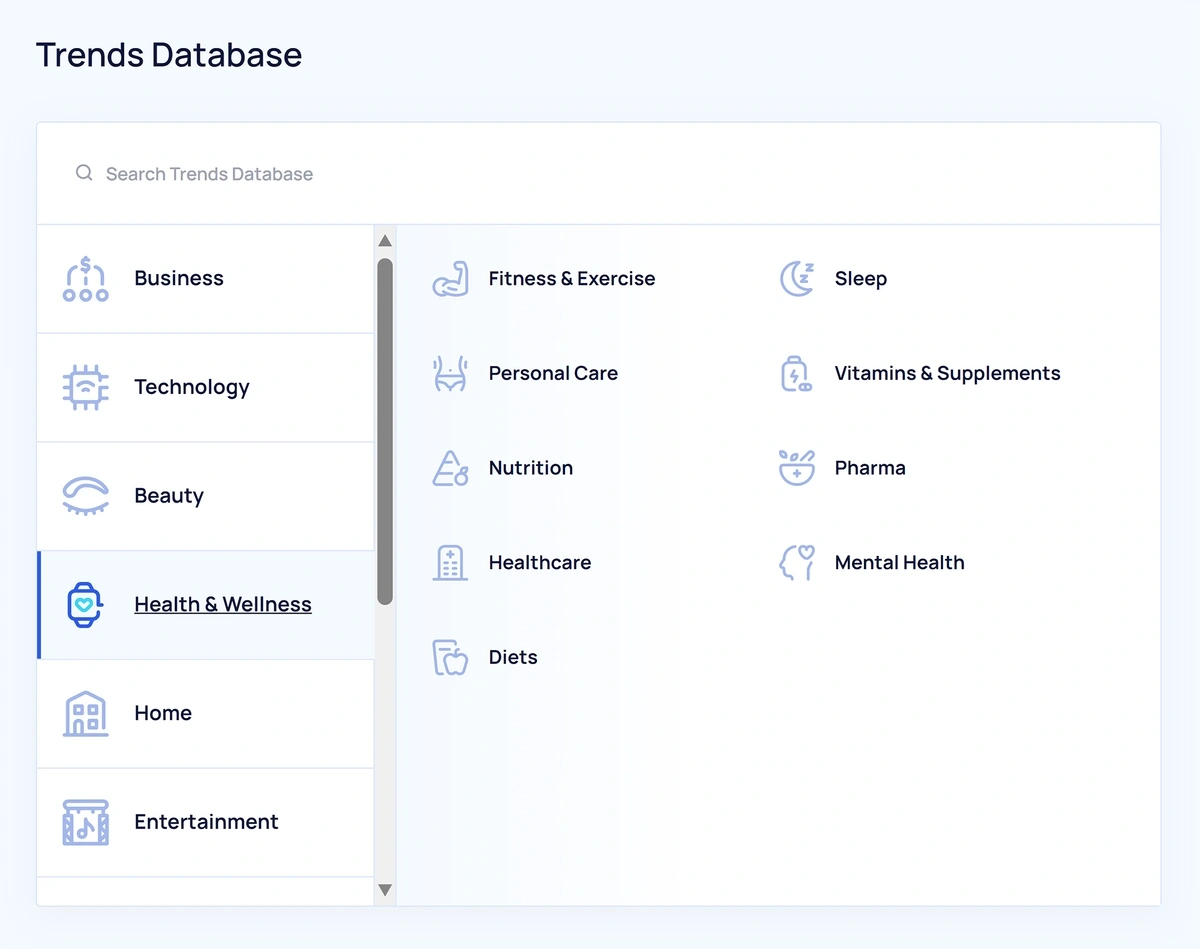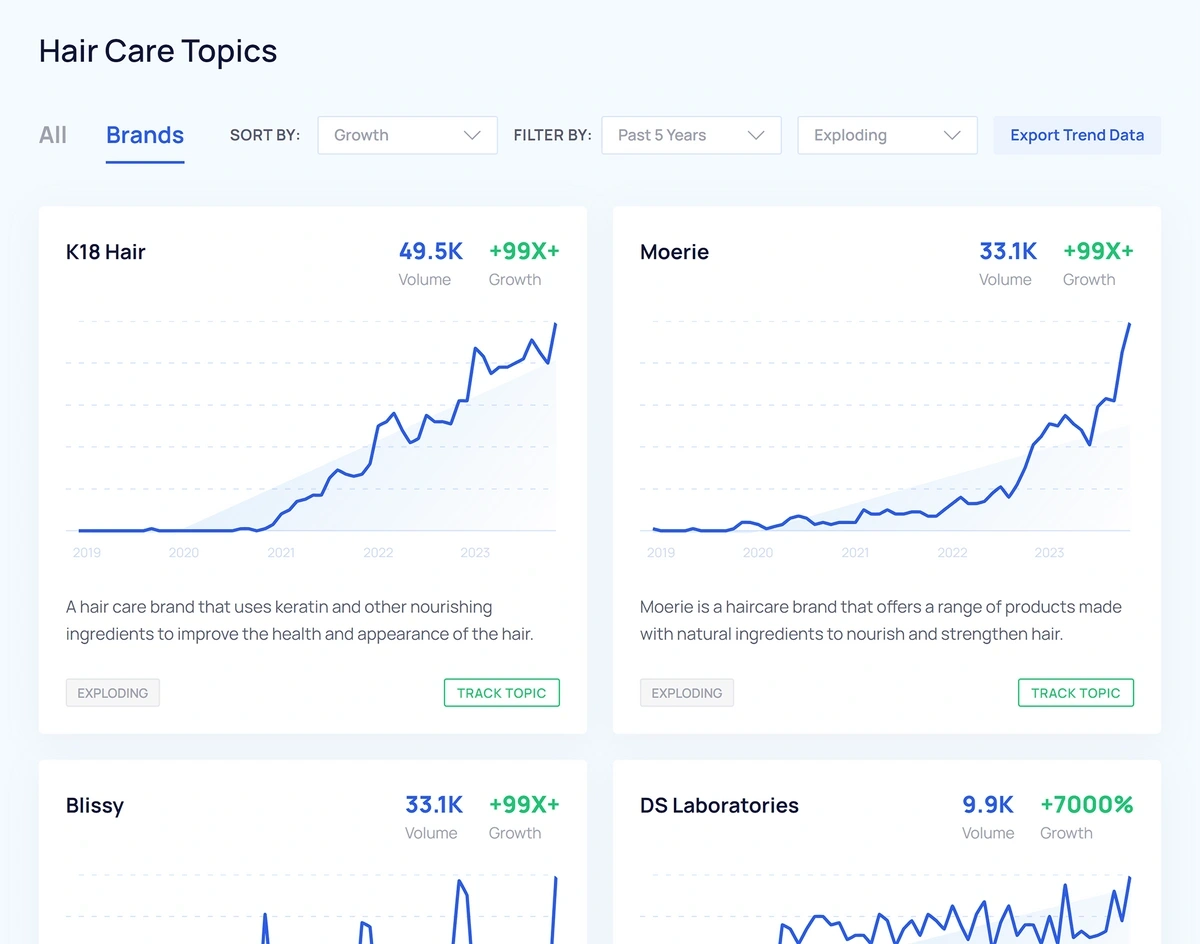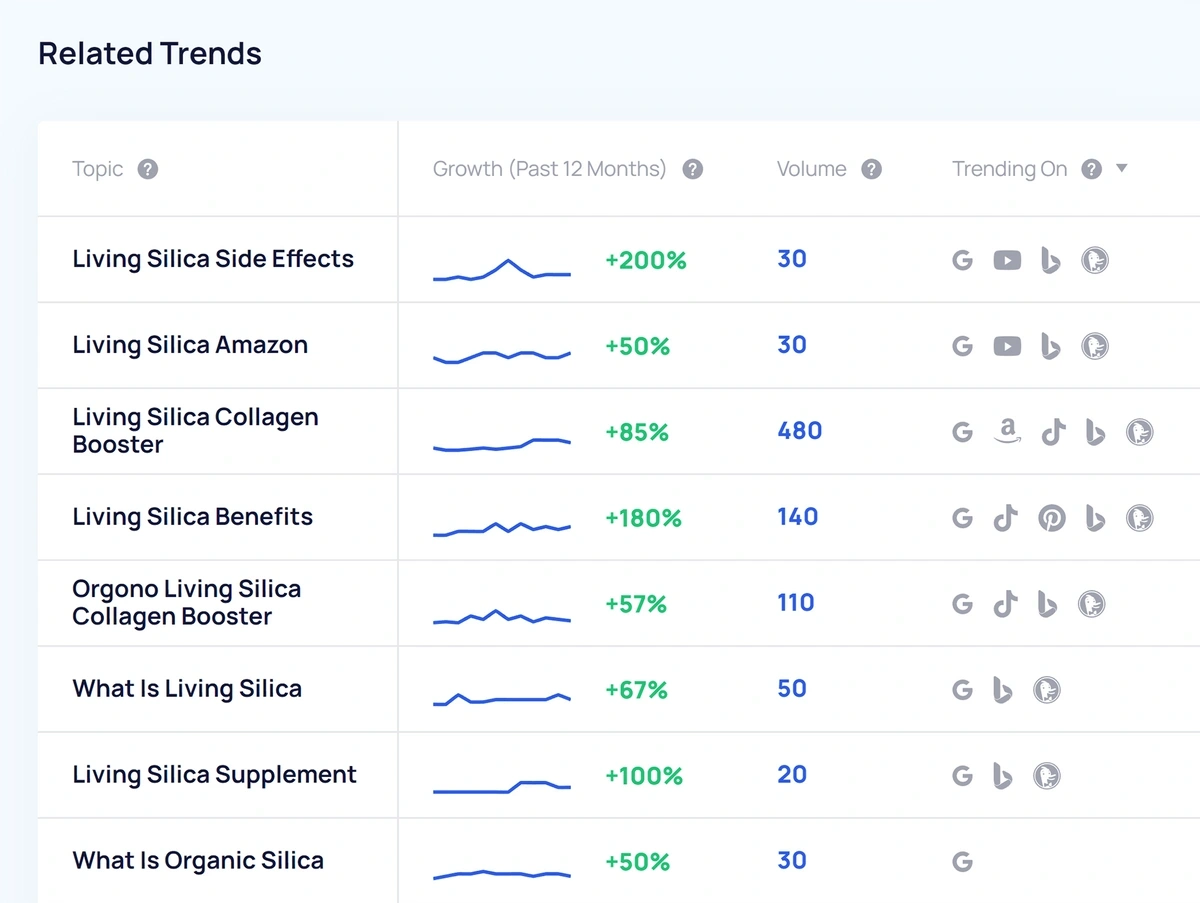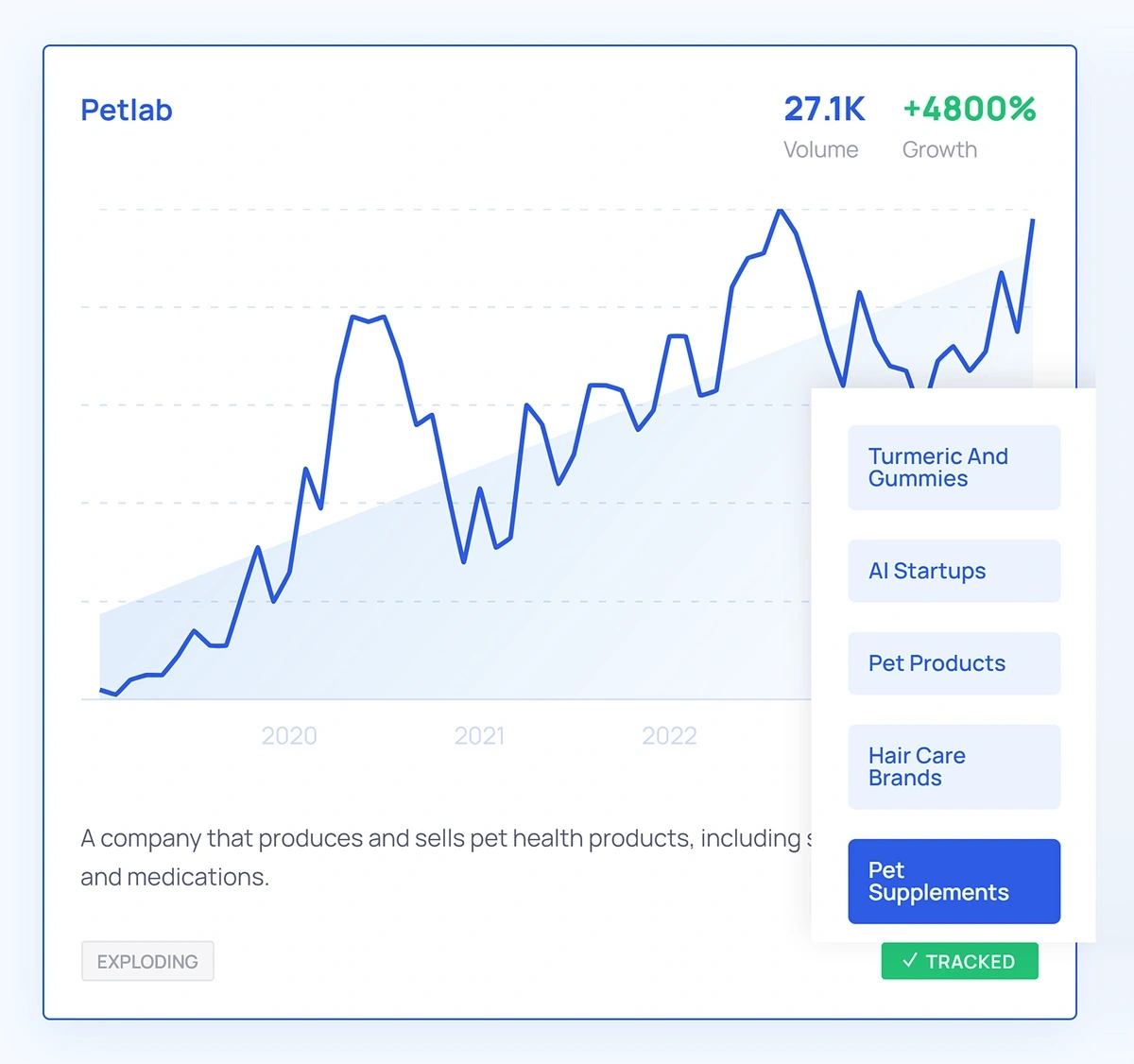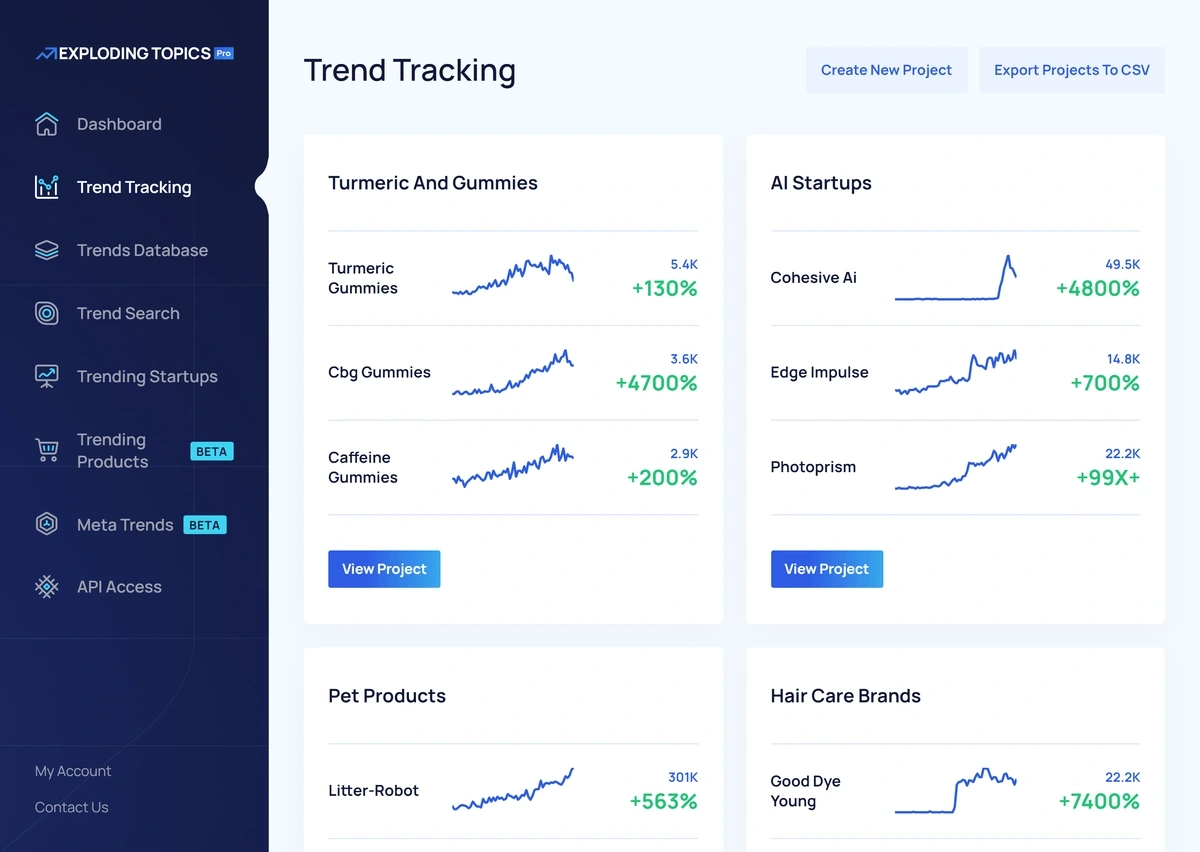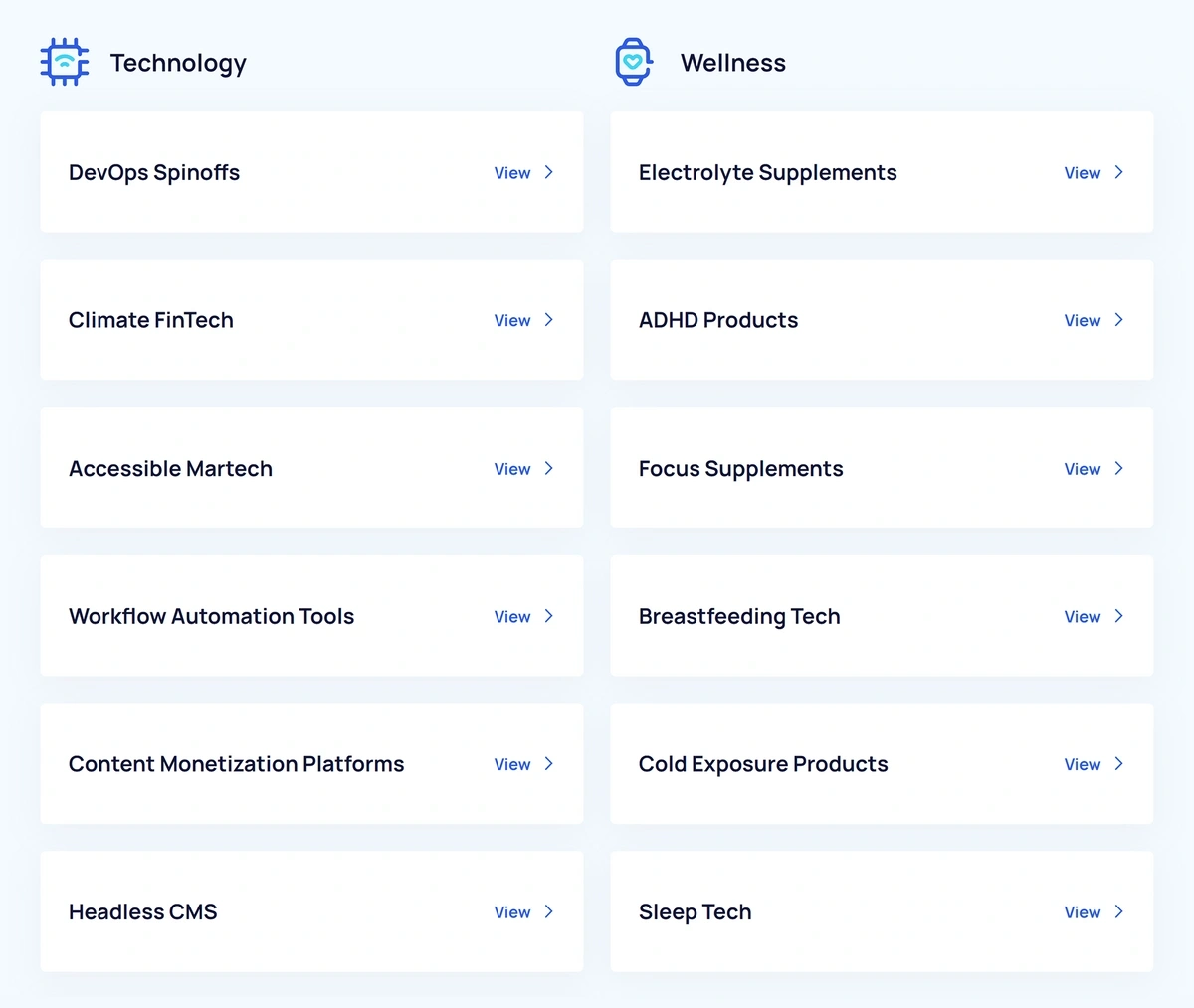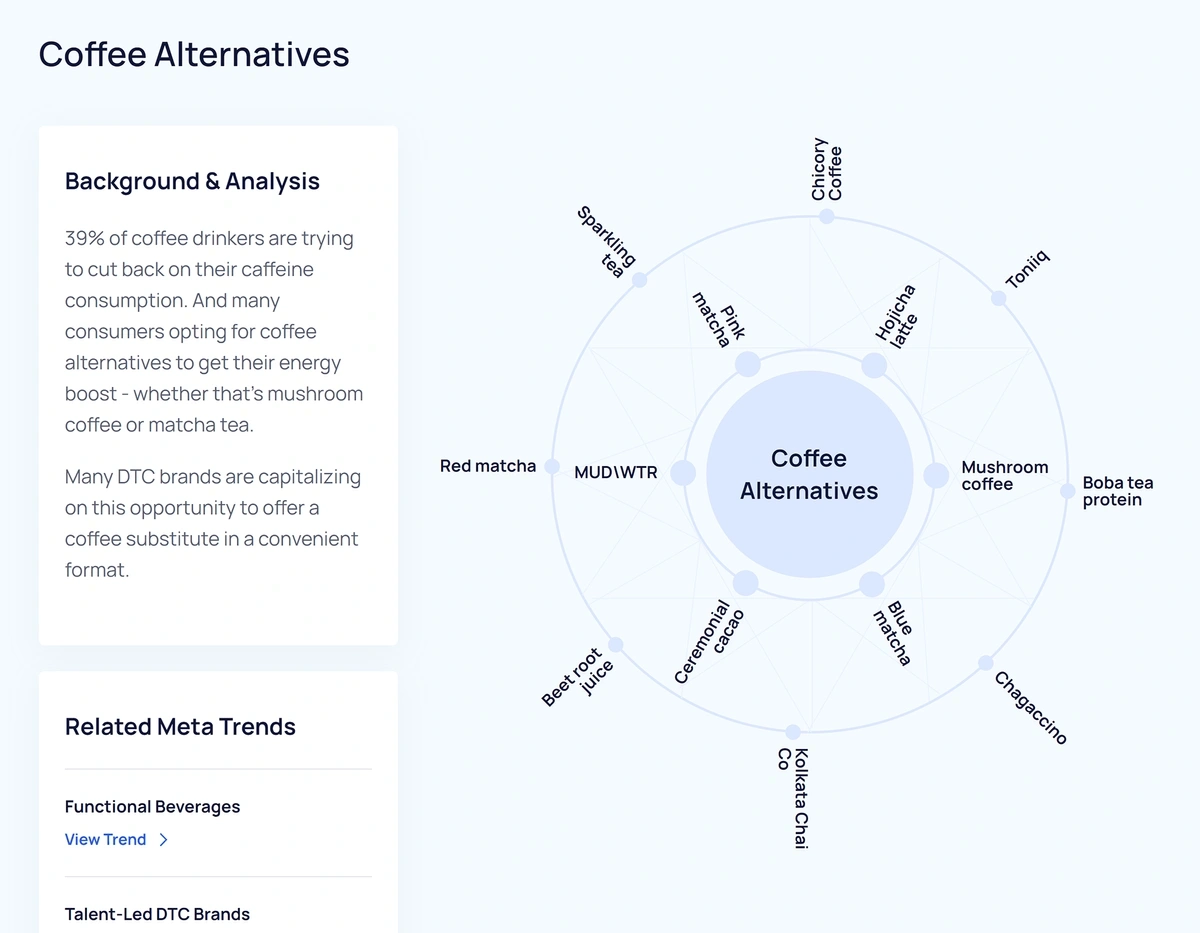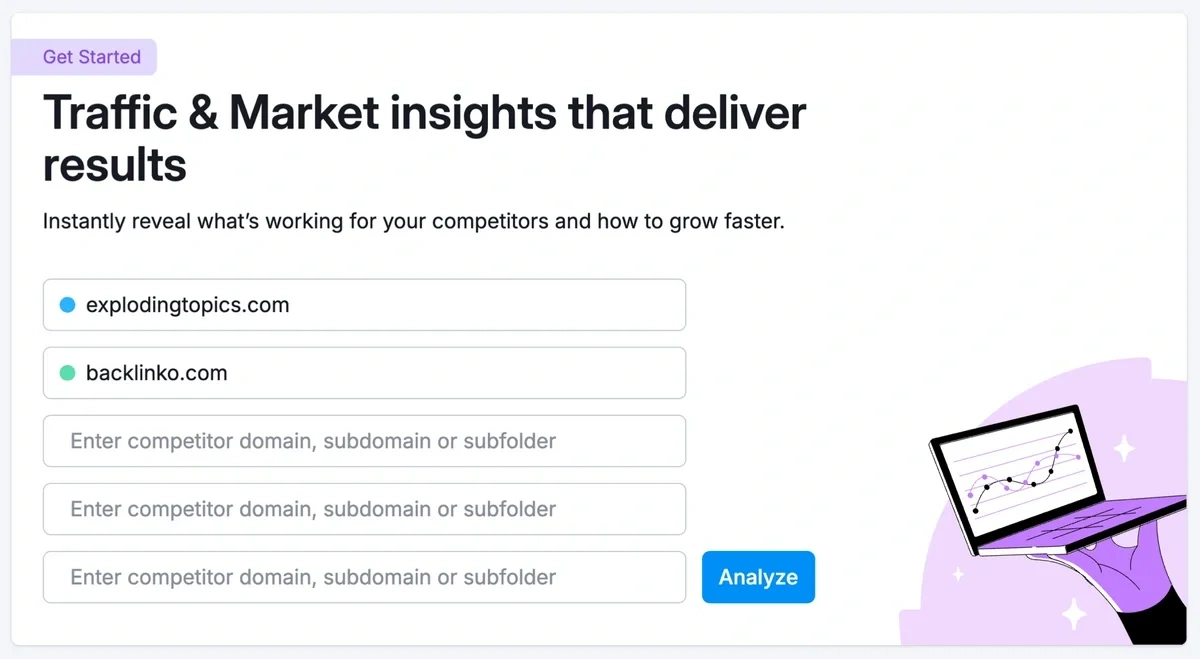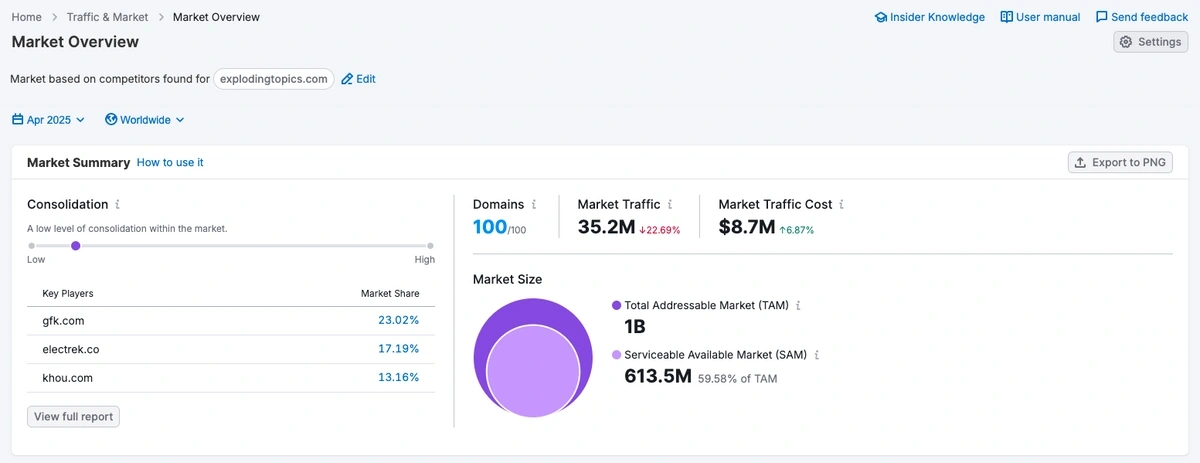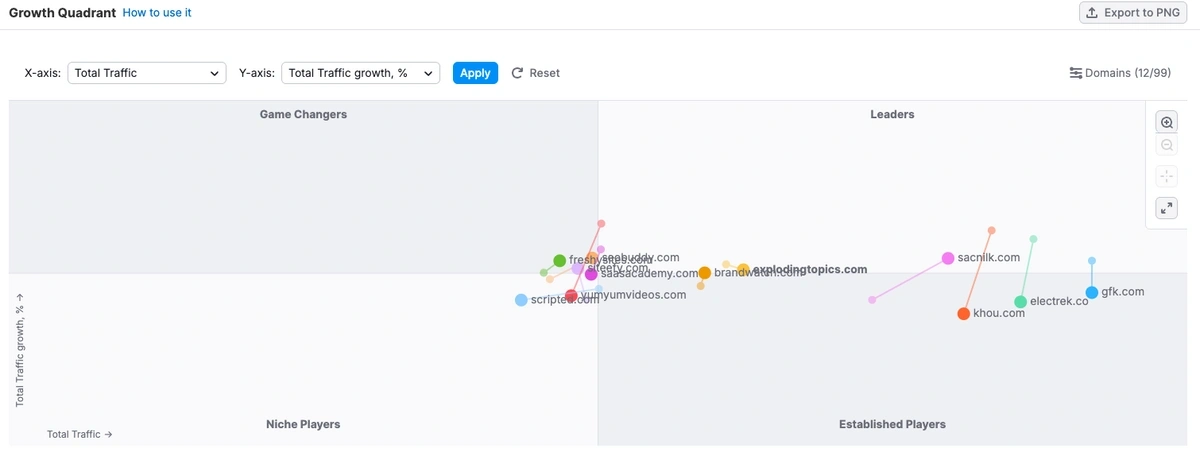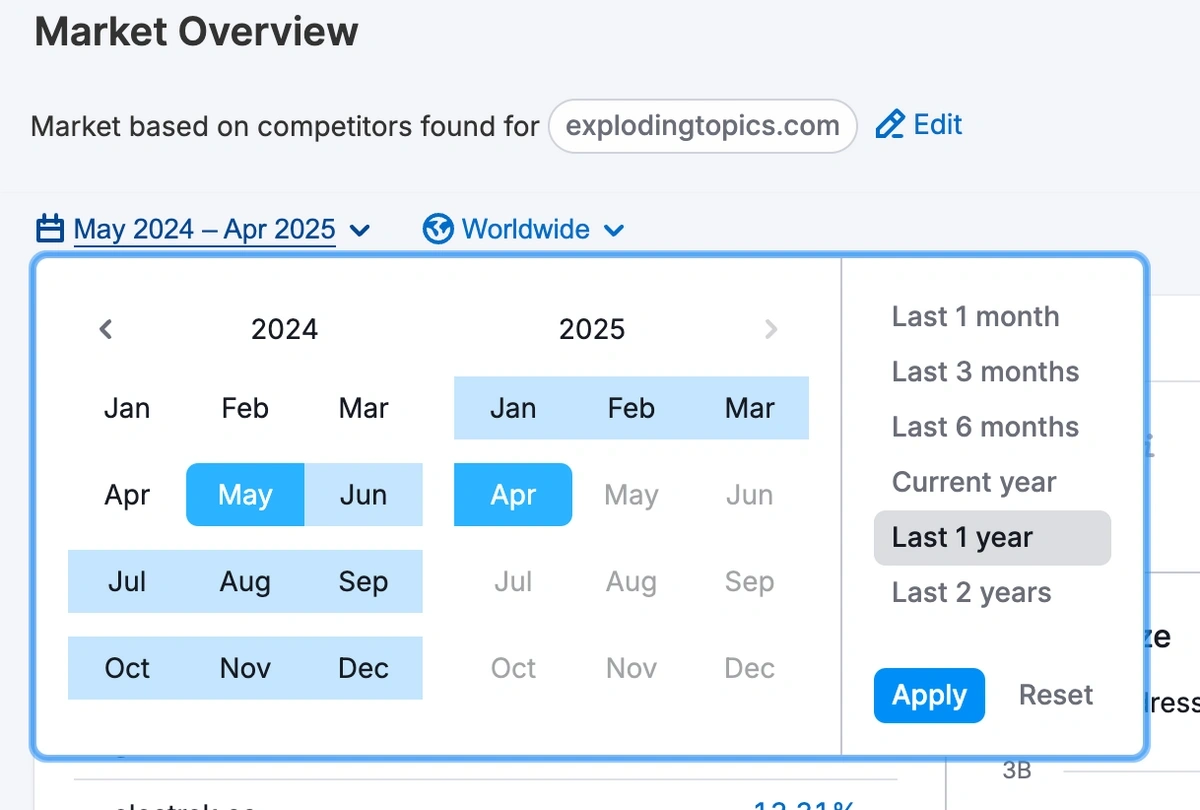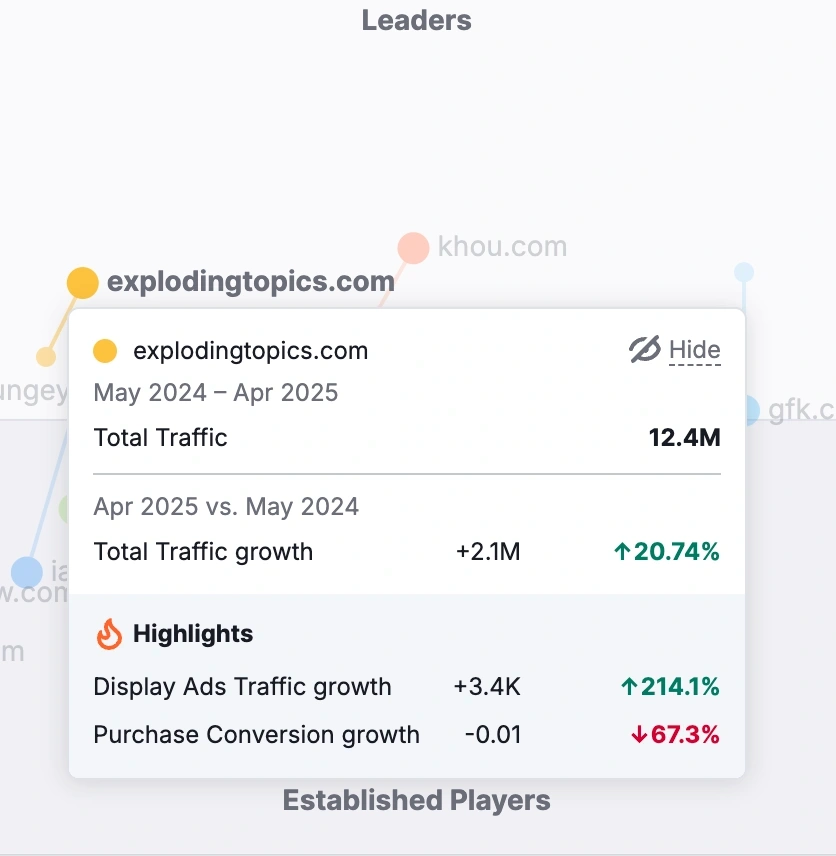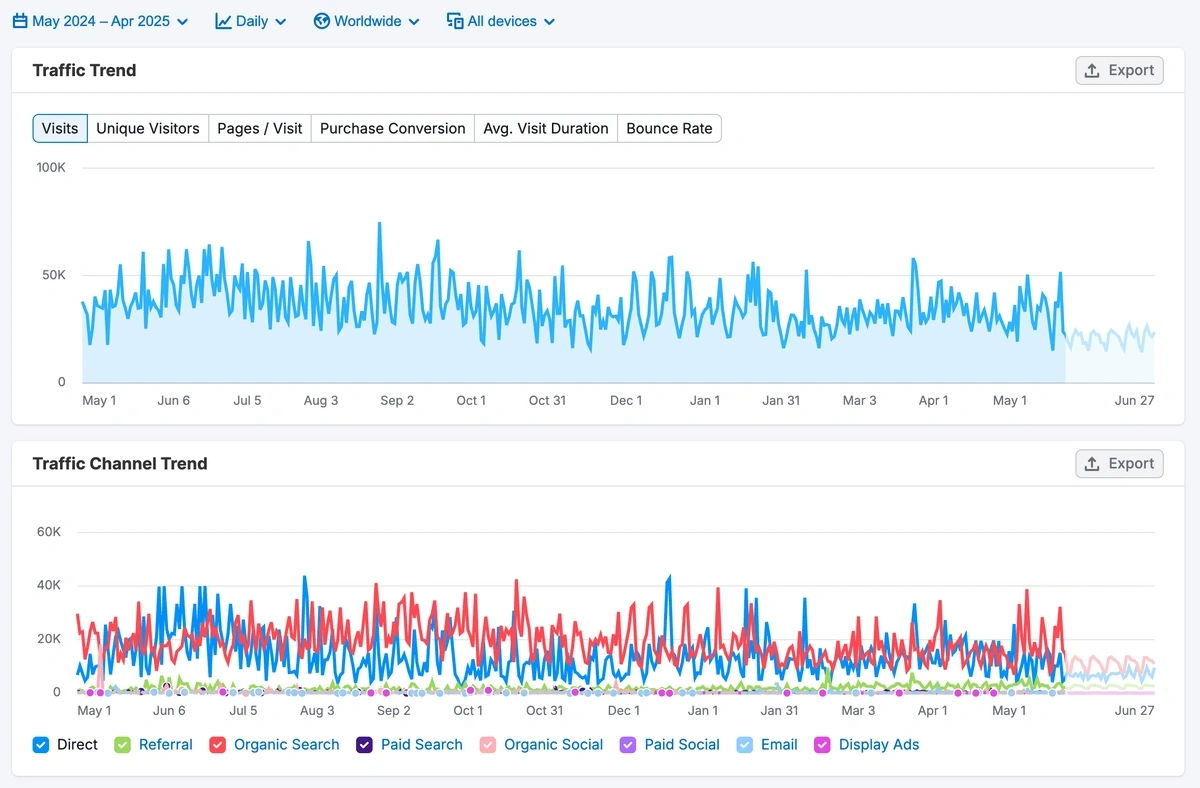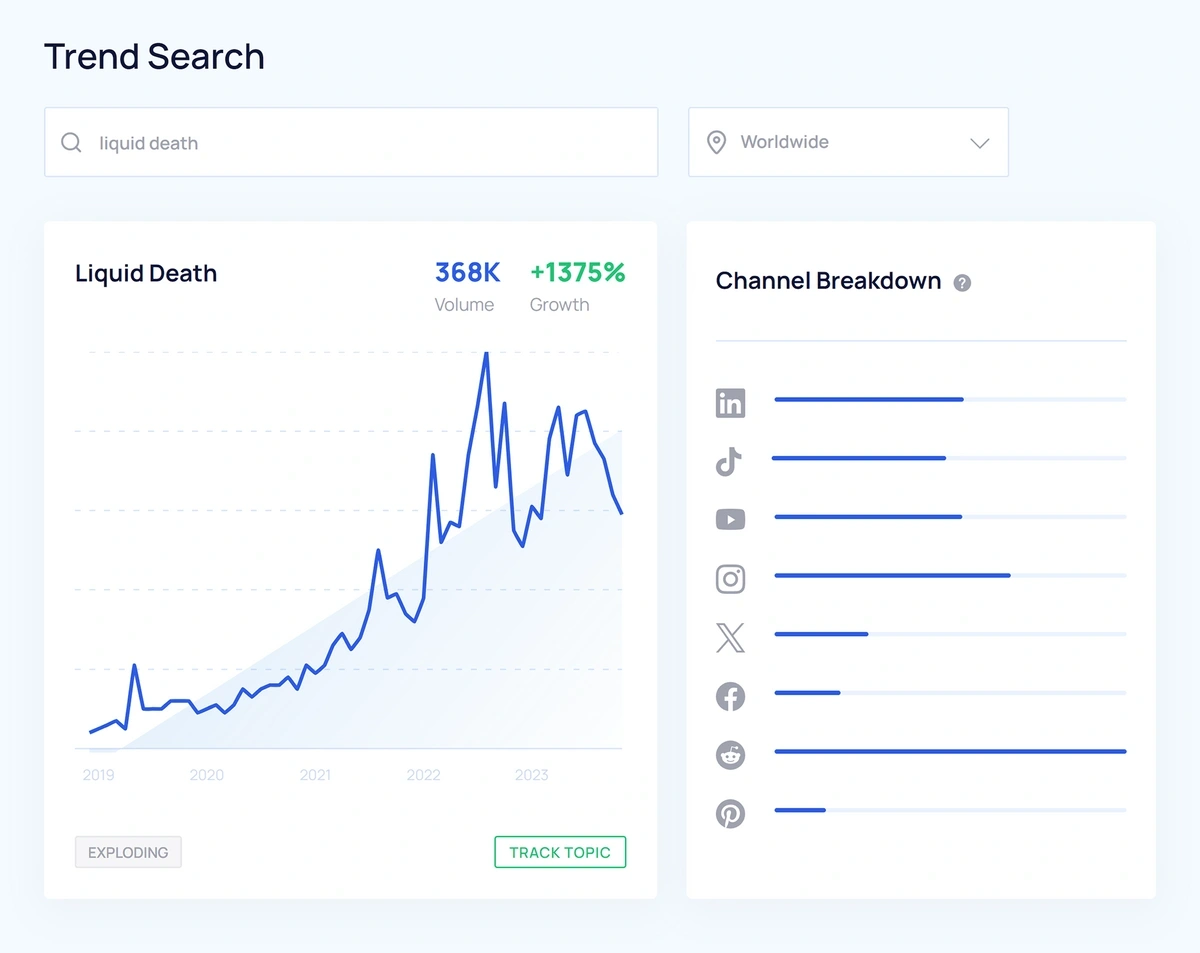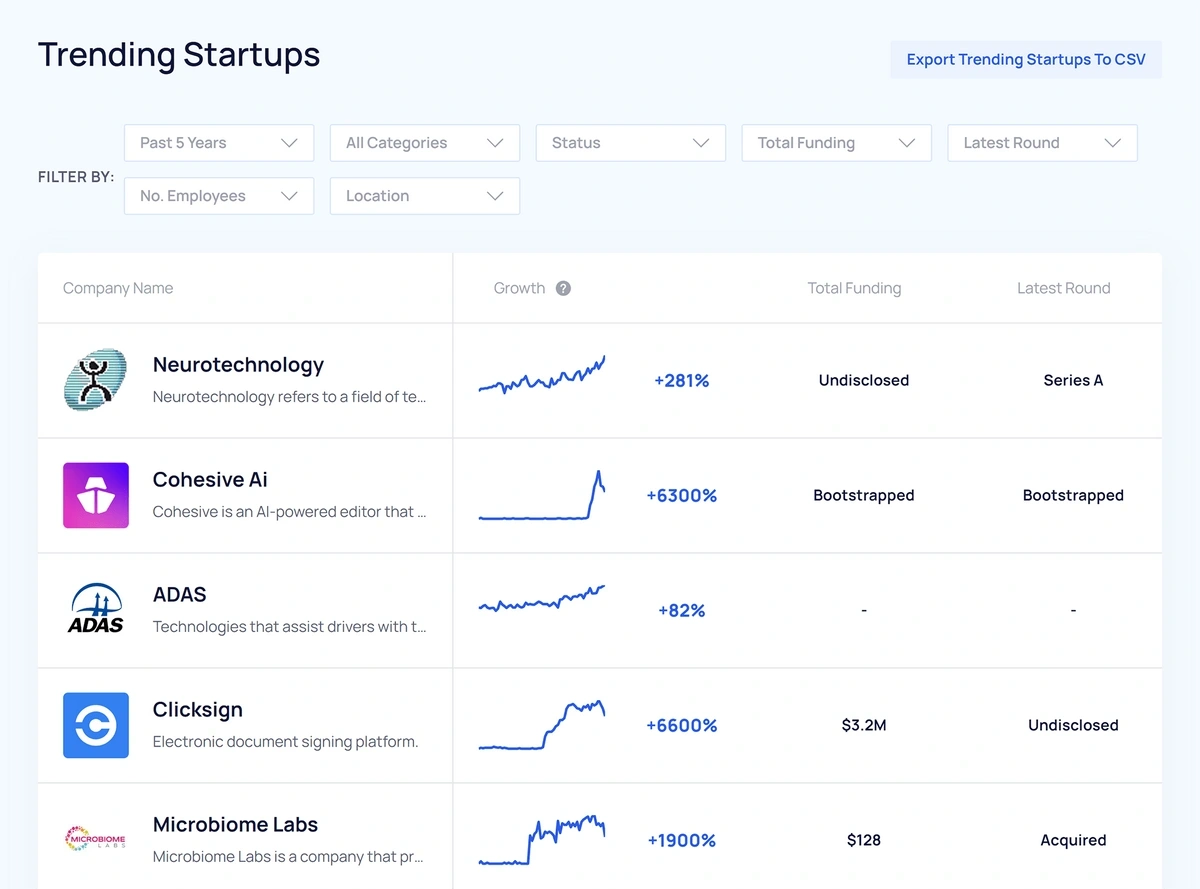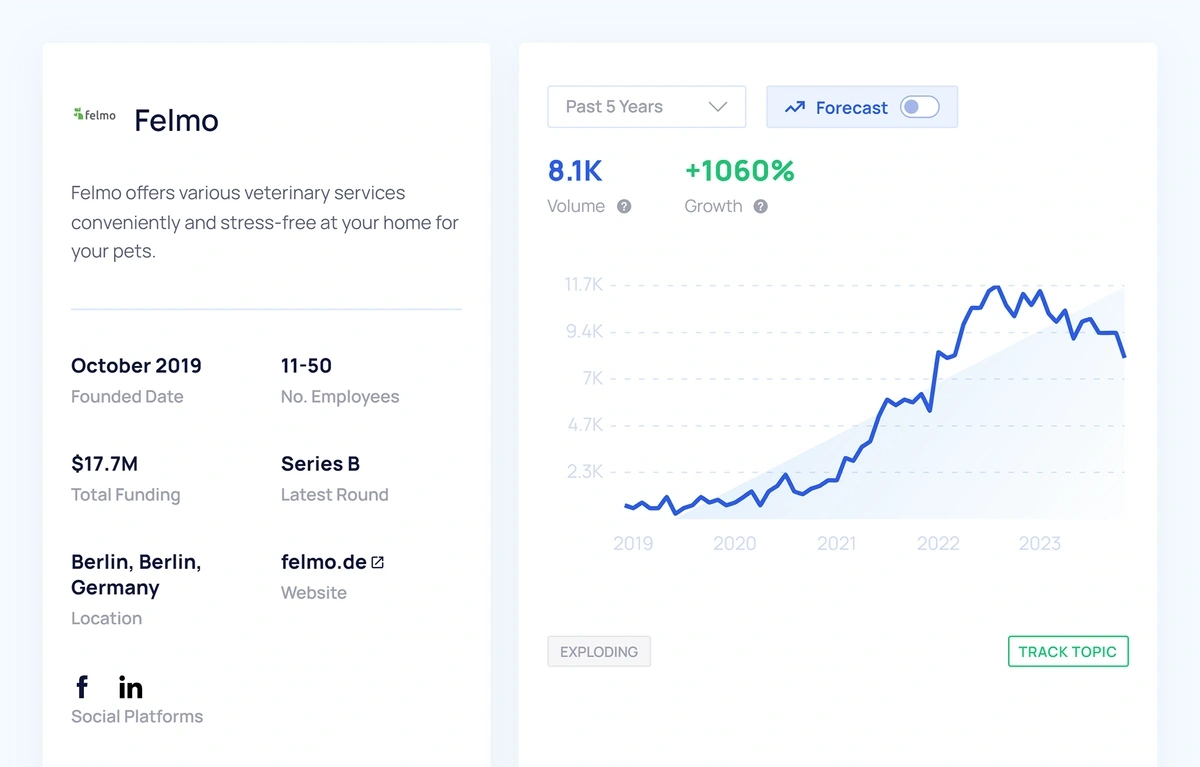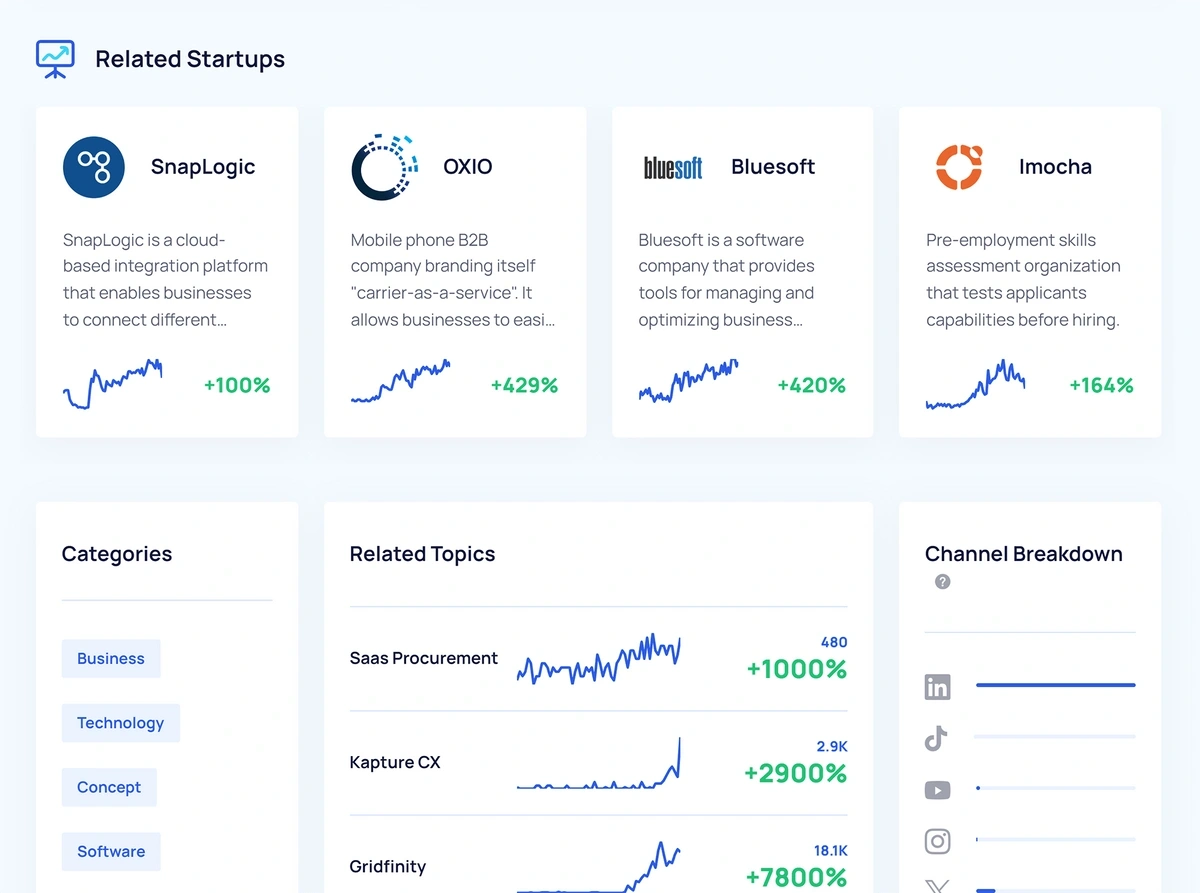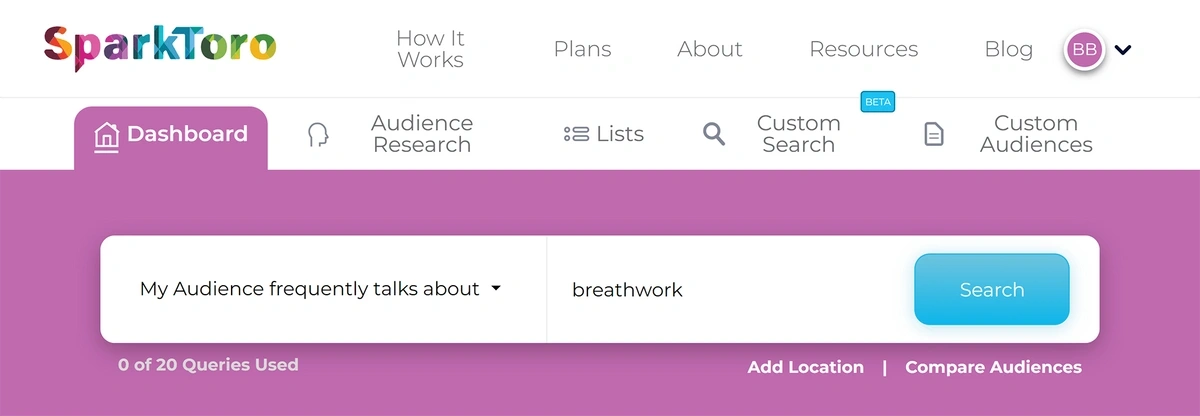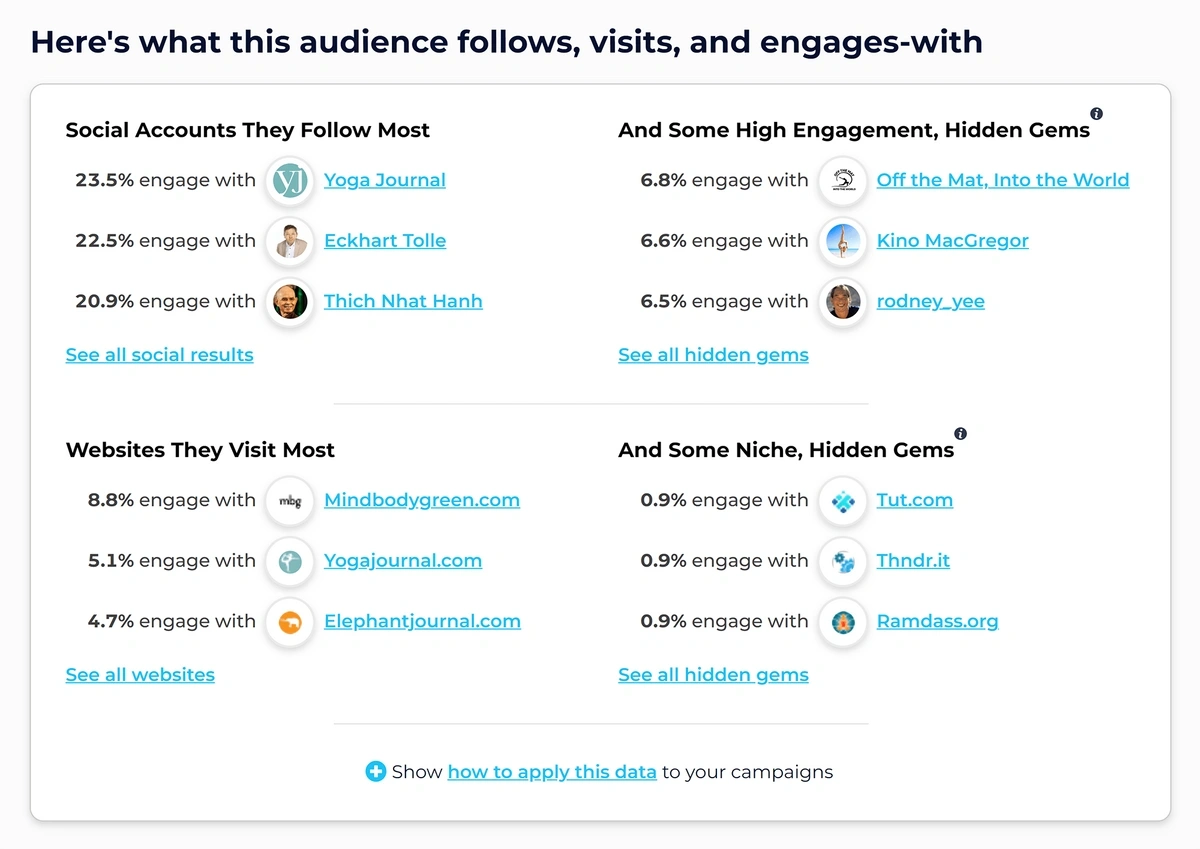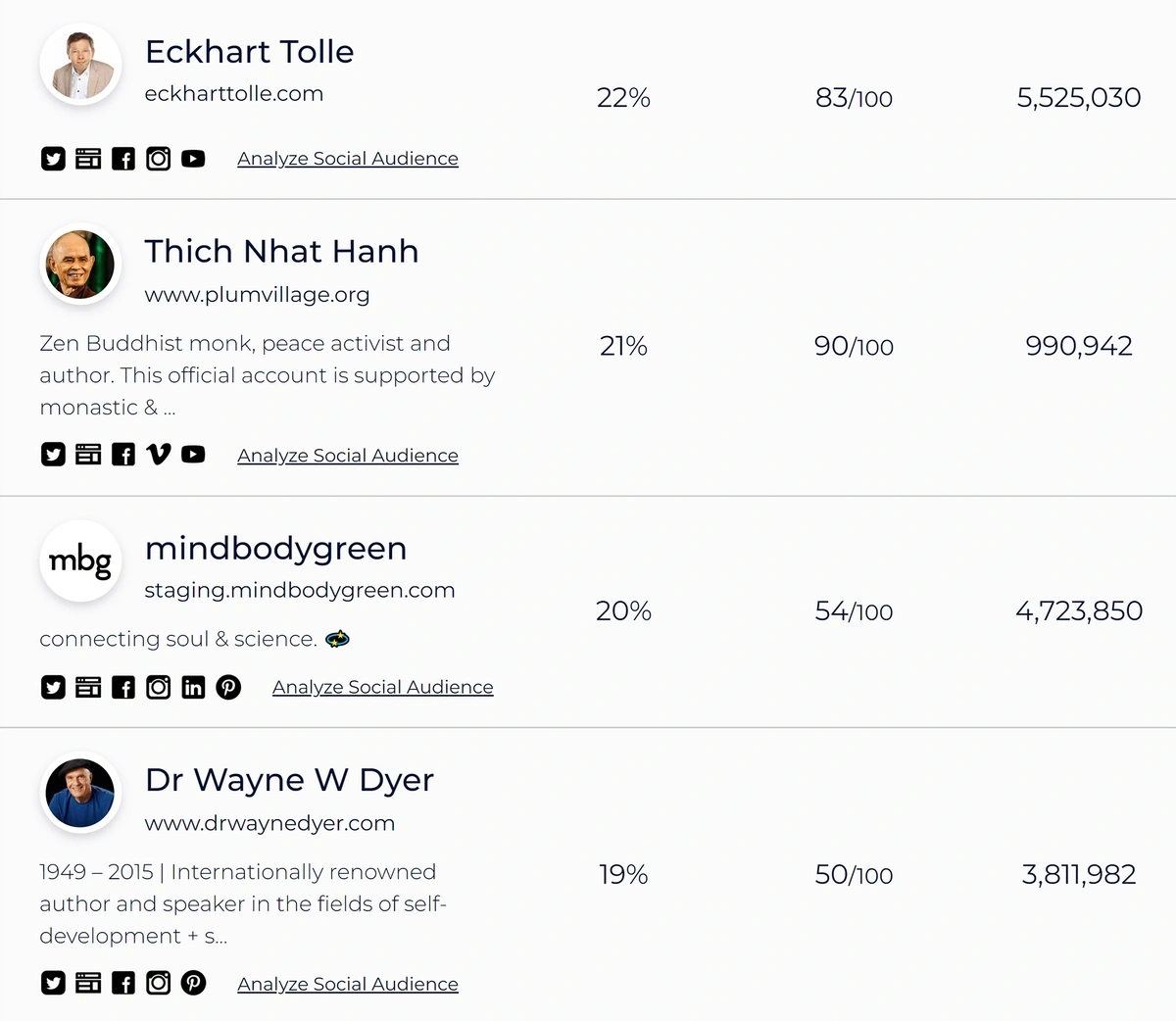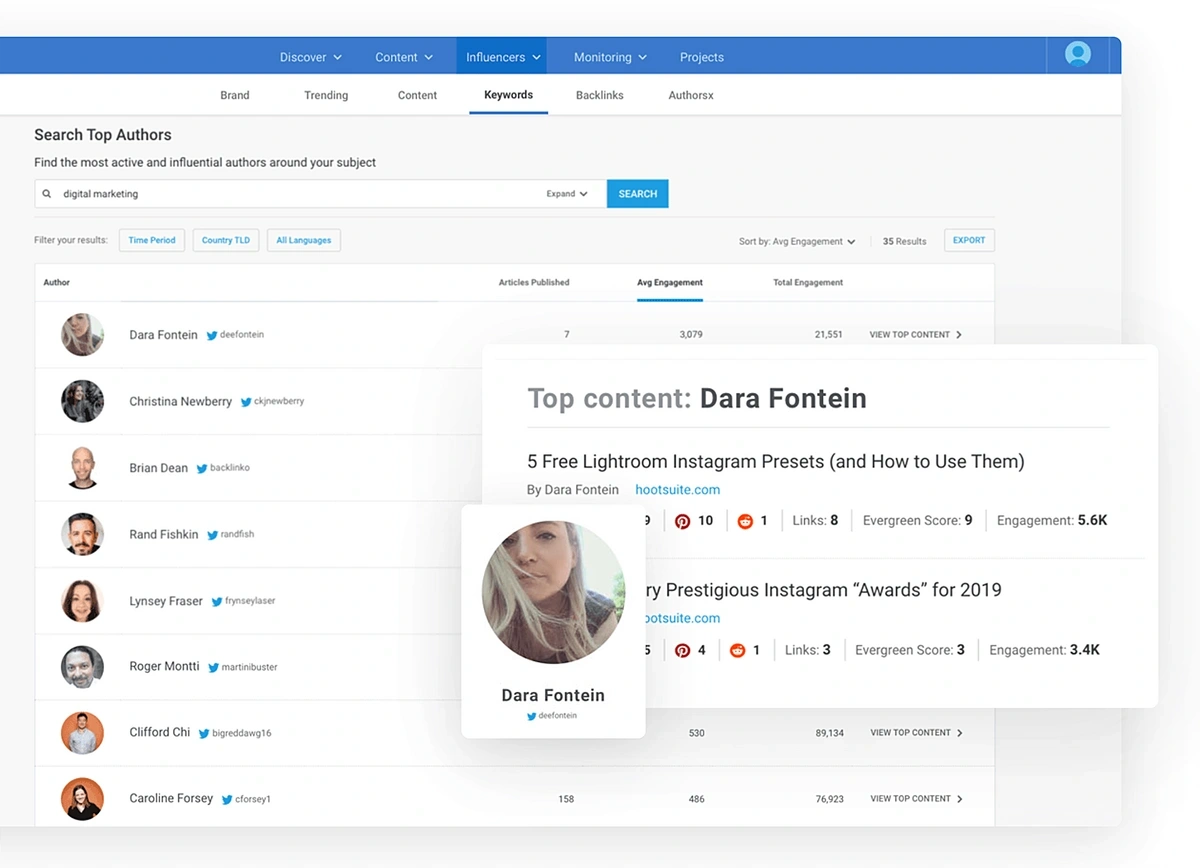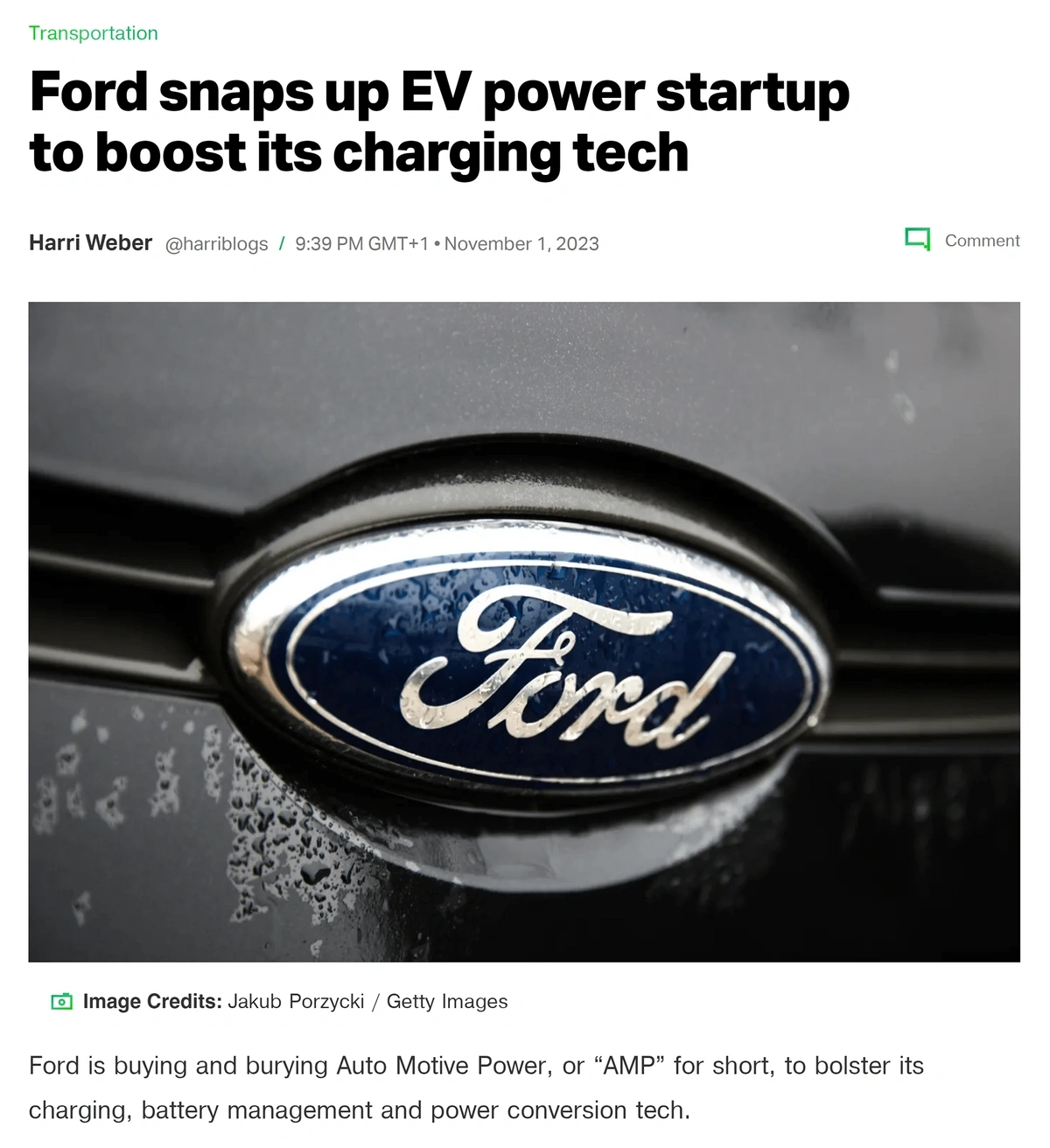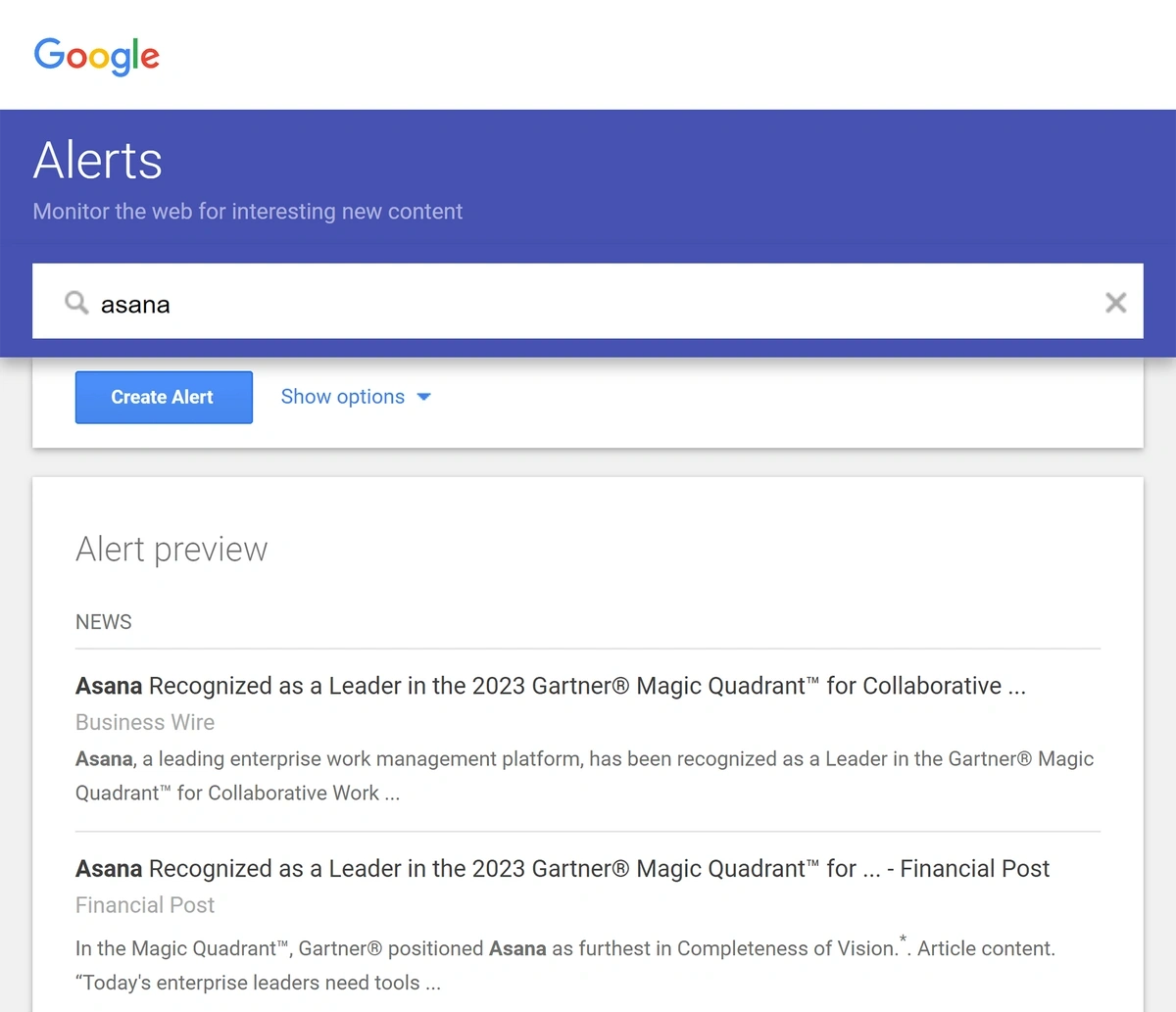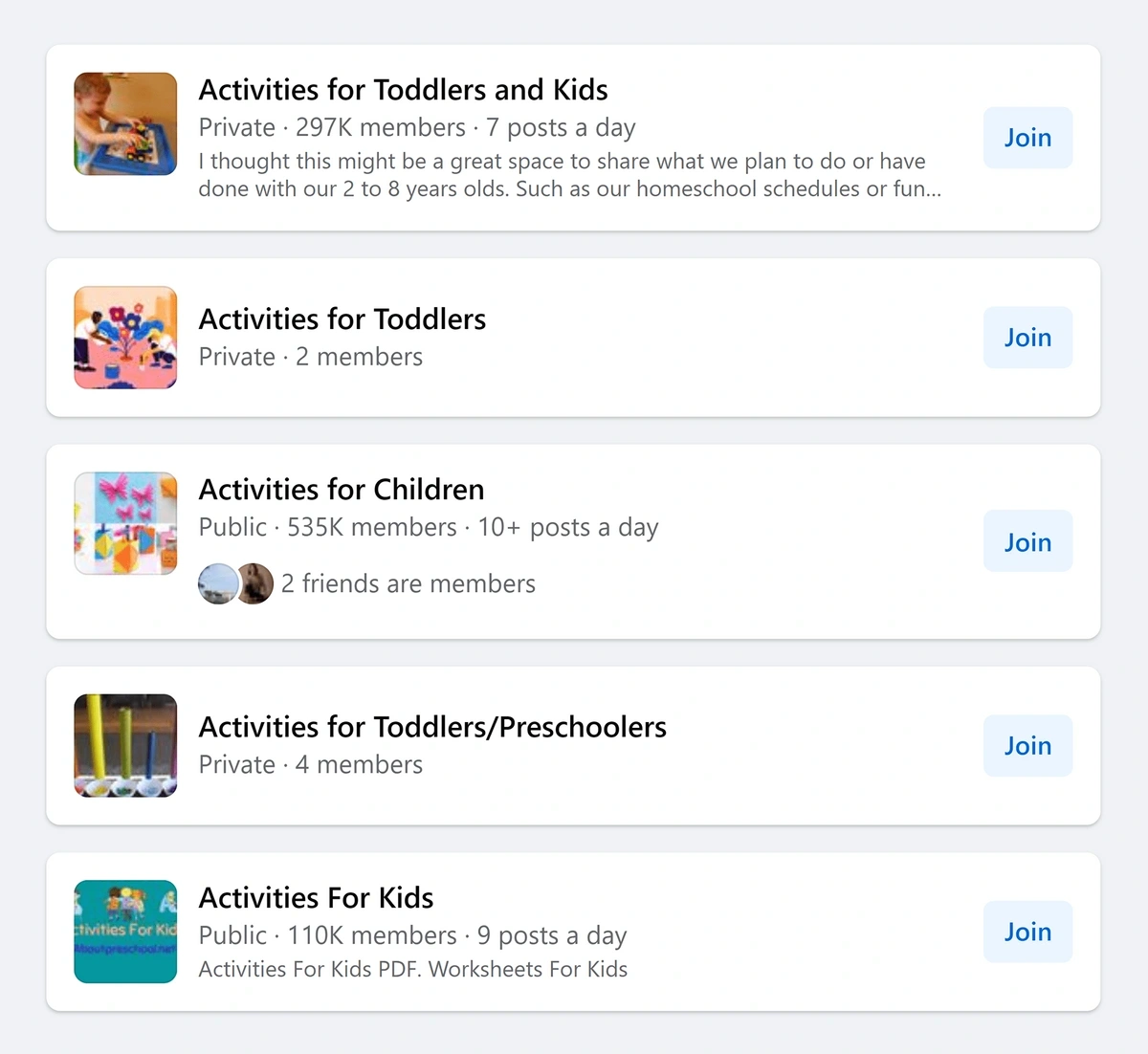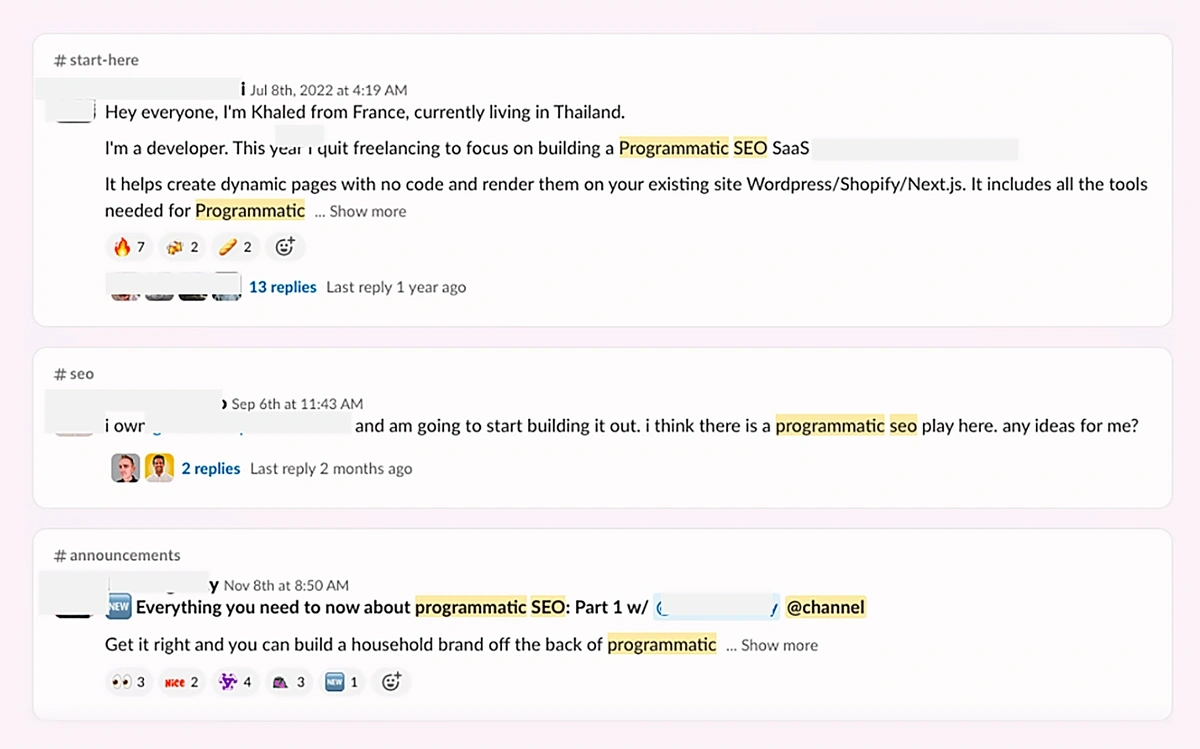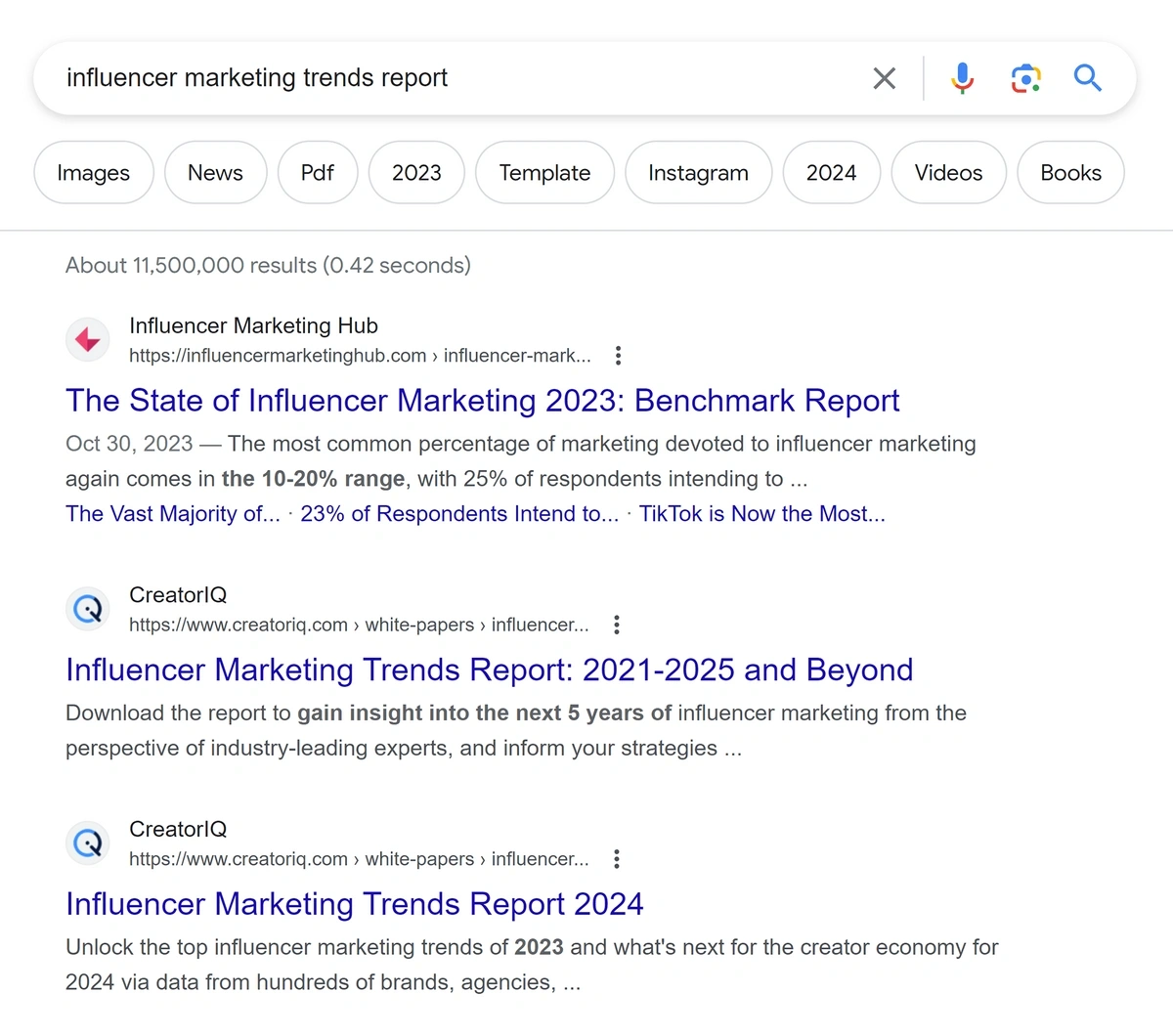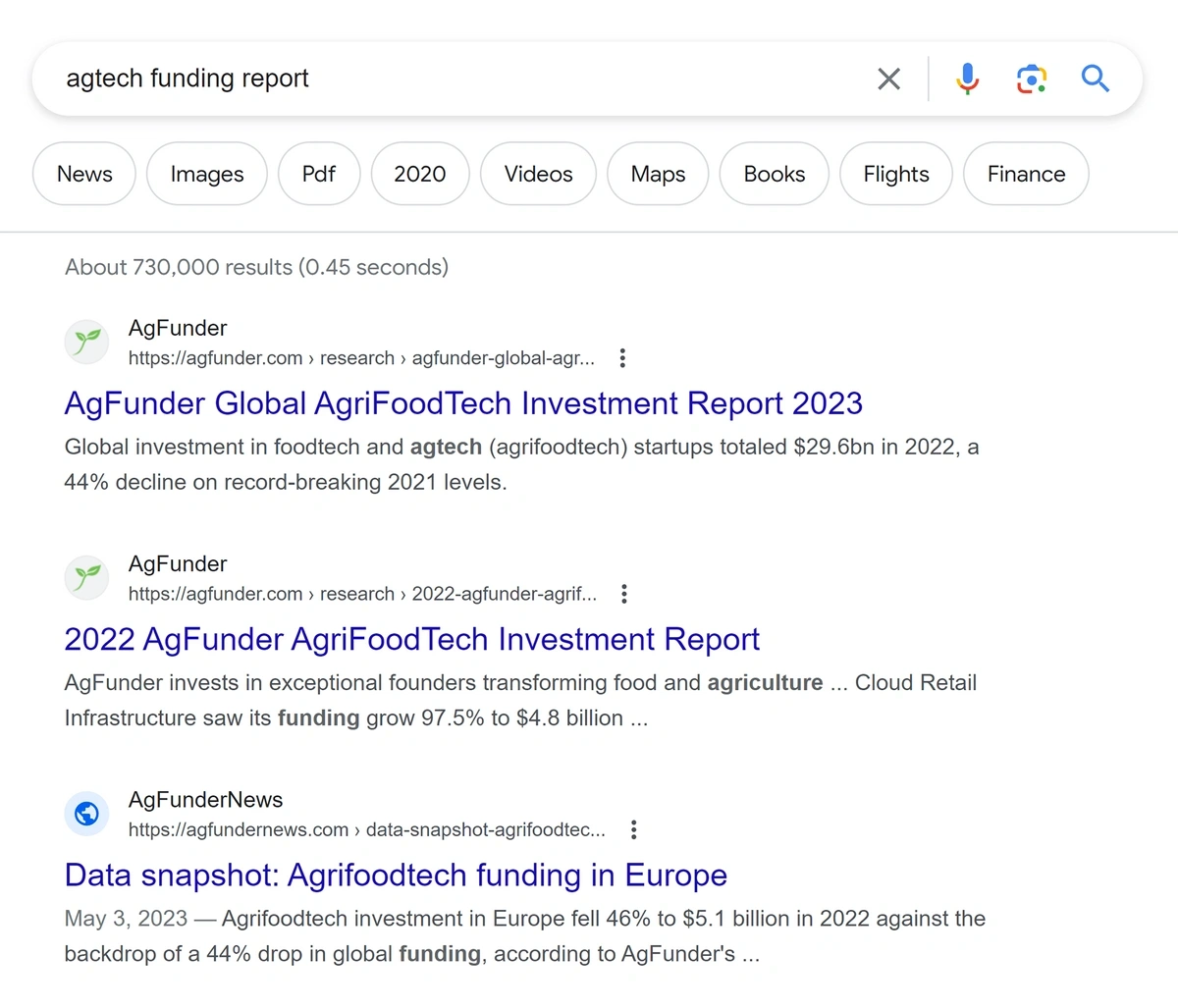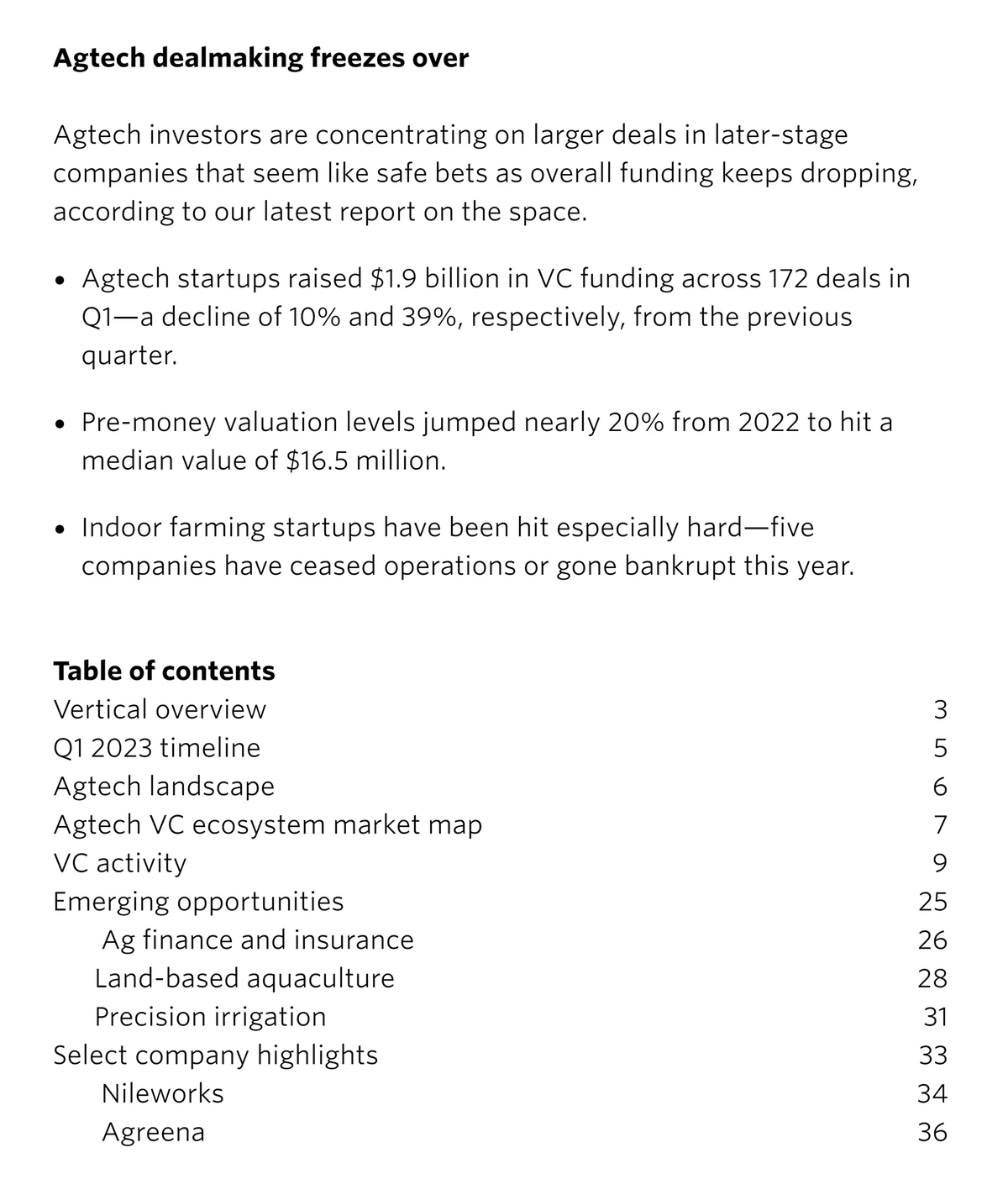
How to Monitor Industry Trends: 9 Efficient Methods
Most people read industry publications and browse social media to monitor industry trends.
Yet this approach isn't very efficient. It might take you a few hours to identify a handful of trends, and there's still a good chance you'll overlook critical emerging trends.
In this post, we'll share some proven methods to identify and monitor industry trends.
1. Use a Trend Discovery Tool
A trend discovery tool can cut the trend discovery process from hours to minutes.
Instead of browsing through endless content, a trend discovery tool provides a database of pre-selected trending topics.
This is how our trend discovery tool, Exploding Topics, works. You can select a category and instantly see a list of relevant trending topics:
However, trend quality varies from tool to tool. Each has its own trend discovery and qualification process.
What are the issues with many trend discovery tools?
We found that many trend discovery tools have limitations:
- They only identify current, peaking trends rather than emerging trends
- They include fads (topics that quickly gain traction and then die out in a matter of weeks) rather than sustainable, long-term trends
- Many trends are related to pop culture and irrelevant to business use cases
- They lack consistency and often overlook the most important emerging trends
We built Exploding Topics to solve each of these problems.
Specifically, our trend identification and qualification process is the key reason it consistently identifies emerging industry trends.
First, we use AI and machine learning to scan billions of data points from sources like:
- Google Search
- Amazon
- Spotify
- YouTube
- Other social media channels
Then, it flags topics that are gaining traction. This process is why Exploding Topics is unlikely to miss emerging industry trends.
Finally, human analysts manually review each flagged topic and only approve topics that both:
- Show long-term growth potential (based on historical Google Search volume growth)
- Are relevant to business use cases (the topic is a product, brand, or industry keyword)
| Our Methodology | Why It Matters |
| Exploding Topics' AI and ML scan billions of sources in real time and flag trending topics | Exploding Topics consistently identifies emerging trends rather than current trends. With so many data sources, it's unlikely to miss new trends. |
| Exploding Topics analyzes Google Search volume growth and qualifies topics with compounding growth | You only see trends with long-term growth potential, not fads. |
| Exploding Topics checks topics for business relevancy (not trending news or pop culture topics) | All trends are relevant to business use cases. |
This trend identification and qualification approach is a key differentiator that makes Exploding Topics highly effective at consistently identifying emerging industry trends.
It's also easy to use.
First, select one of the dozens of B2B or B2C categories ranging from fitness and fashion to AI and supply chain:
Then, you'll see a list of relevant trending topics and their Google Search volume growth trend. This data makes it easy to instantly gauge a trend's growth and stability.
You can also filter the database by growth status (Exploding, Regular, and Peaked) and adjust the time period.
When you find a topic that interests you, click on it for more details, like a forecast of its future growth and a breakdown of the topic's activity across various social media platforms.
If you scroll down, you’ll also see a list of other related trending topics that might interest you:
To save a trend, click "Track Topic" and save it to a Project.
Projects are files you create and name, and they live in the Trend Tracking dashboard.
Once you've created Projects, Exploding Topics continues to update each trend with real-time data.
So you can monitor trend growth by just glancing at the Trend Tracking dashboard.
The Meta Trends dashboard is another feature you can use to identify related trends within a growing category.
You can click on any niche to see a list of related products, brands, and search terms:
2. Track Website Activity
Another way to stay on top of your industry's latest trends is to analyze competitors' website activity.
The Semrush Traffic & Market Toolkit includes various features that can be useful for competitive analysis to explore market trends.
This tool primarily serves as a way for businesses to compare themselves to other competitors in their industry.
But how exactly does this help you monitor industry trends?
To get started, click the Market Overview tab and enter your domain to generate a market summary report.
The Market Summary report provides a snapshot of key industry trends. This includes:
- Market Consolidation
- Key Players
- Market Domains
- Market Traffic & Traffic Growth
- Market Traffic Cost & Cost Growth
- Market Size
These metrics can unlock hidden insights into your overall market and where you stand within a specific niche.
For example, low market consolidation means the industry's market share is distributed among many players. Competing in a space like this means you have room to grow.
This metric can measure and monitor how a specific market is evolving over time. Specifically, this can help you:
- Identify emerging competitors that are gaining market share
- Spot industry consolidation trends, such as mergers and acquisitions
- Recognize opportunities for market entry or expansion
The tool also creates a “Growth Quadrant” that shows your market position relative to your competitors.
Industry players are divided into four quadrants: Leaders, Established Players, Game Changers, and Niche Players.
- Niche Players: Anybody in this quadrant is either new or has yet to grow a larger audience. This can indicate low or stagnant traffic with low growth rates.
- Game Changers: Players here also have low traffic but are showing above-average growth rates compared to others in this space.
- Leaders: Here, you’ll find the players in your sector with large audiences and high growth rates. They have the best traffic and many customers.
- Established Players: Any sites in this quadrant have a big audience but low growth rates. That means traffic is steady or even slightly declining, so there won’t be many spikes in traffic for sites here.
You can use this data to monitor industry trends in two ways.
First, analyze the growth paths of individual websites. Open the calendar at the top of the page and adjust the dates to show the data for the last year.
With this new data, you can view growth paths for sites on the rise with positive traffic growth over the past year.
For example, our site’s growth from 2024-2025 launched us into the Leaders quadrant in our space.
When you see a site that has grown like this, you can view what caused these spikes or dips in traffic.
You can find industry trends worth monitoring within these traffic changes, such as specific content topics or new marketing strategies.
To learn why, we can view the type of content we've published, ads we've run, blog topics we've published, etc. Use this strategy to find hidden industry trends that others are missing, and double down on these tactics.
Second, use the Daily Trends report to identify new trends or analyze existing ones specific to your traffic activity.
Within each domain, you can compare the site's total traffic growth to the market’s, the most popular traffic channels to the market's, and audience data to the market’s.
Examine the overall shape of the market's traffic graph to find different patterns, such as:
- Recurring spikes might indicate seasonal trends
- Sudden drops could signal industry-wide challenges
- Gradual inclines may suggest growing market interest
Once you've grasped the market-wide trends, shift your focus to individual competitors:
- Identify sites that show growth during market downturns
- Look for competitors maintaining stability amidst market volatility
- Spot newcomers experiencing rapid traffic increases
For companies bucking the overall market trend, dig deeper. Analyze their content strategy during successful periods.
- Did they cover new topics?
- Did they try different content templates or frameworks?
- Did they announce a new product launch?
- Did they run a new marketing campaign?
While the Daily Trends tool provides a broad overview, complementing this analysis with more granular competitive research will help you monitor industry trends more accurately.
Consider using additional Semrush tools and other strategies mentioned in this guide to monitor industry trends and stay ahead of your competitors.
Sign up for a free account today.
3. Track Growing Startups
An easy way to find trends with validated market demand is to look for brands with a rapidly growing customer base.
Most brands don't publish revenue numbers, but you can gauge a company's growth by looking at its Google Search volume trend.
There are also some AI search monitoring tools you can use.
If you already know of a few brands you want to track, you can use the Trends Search feature in Exploding Topics or Google Trends to see a graph of that brand’s Google Search volume trend:
But the bigger challenge is discovering emerging, growing brands.
To solve this problem, we built the Trending Startups feature.
It makes it easy to quickly view a list of growing startups in your industry.
The Trending Startups feature is similar to the Trending Topics database.
You can sort the database by industry (e.g., health, pets, fashion, finance, etc.), and you'll see a list of startups and a graph of their Google Search volume trend.
You can also filter the database by other metrics, like total funding amount, funding round, number of employees, location, and more.
To learn more about a startup, click on it to view more details and the brand's growth forecast for the next 12 months.
You can also scroll down to see other related trending startups, topics (brands, keywords, and products), and a breakdown of the social media channels the brand is trending on.
4. Track Influencers on Social Media
Following industry influencers is a great way to monitor industry trends for two main reasons:
- They have large networks and are often the first to learn about new industry trends.
- They are incentivized to post content about emerging trends, as trending content tends to perform well.
You can use a tool like SparkToro to determine which influencers your audience follows.
Set the filter to "My Audience Frequently Talks About" and then type in the trend keyword:
Then scroll down and click on the link that says “See all social results:”
Next, you’ll see a list of the most popular influencers your audience follows:
You can also use a tool like BuzzSumo to find popular creators.
Type in any keyword, and it will show you the top content related to that keyword and the author.
Once you have a list of influencers, you can either follow them from your personal social media accounts or create a separate social media account exclusively for tracking industry trend news.
You can also use an RSS feed tool to provide a list of curated content from specific industry influencers.
You can also use a social media listening tool like Awario, Brand24, or Brandwatch to monitor specific industry keywords or hashtags.
5. Track Competitors
Tracking your competitors' movements can help you stay up-to-date with key industry trends.
Specifically, look at trends your competitors are investing money into.
This example would serve a strong signal to other car manufacturers that they should be making strides to incorporate this technology into their vehicles.
You can also track key executive hires for new departments, as that can also signal key trends your competitors are investing in.
To track major news from your competitors, set up Google Alerts for their brand names. For example, if you want to monitor trends in project management, you can set up alerts for brands like Asana.
If you want a more thorough method to track your competitors’ movements, you can use a competitive intelligence tool like Kompyte or Alpha Sense. Most of these tools automatically track more detailed metrics, like messaging and positioning changes, new job openings and hires, content topics, and more.
Most of them also send you automated reports and let you set alerts to learn about important competitor movements.
6. Listen to Customers
Talking to customers and listening to their conversations is another great method to monitor trends, as their spending habits ultimately decide the trajectory of any market trend.
When customers write reviews, or discuss products online, it's called user generated content.
To connect with your audience, search for Facebook groups, Reddit threads, and other industry forums and read the content that users have contributed.
Then, take note of the topics they discuss most frequently, the pain points they mention, and the products or services they discuss.
For example, programmatic SEO is a marketing trend frequently mentioned in this Slack group:
So if you’re in the $82.3 billion SEO industry, that might be a trend worth researching.
If you wanted to learn more about the trend, you could also ask some of these people discussing the trend to get on a one-on-one call.
7. Read Market Reports
If you're doing formal market research, you can purchase market reports from sources like IBIS World or MarketResearch.com.
These reports offer basic market statistics, like market size and forecast data, and in-depth analysis of consumer spending behavior, the fastest growing market segments, and other market insights.
Pro Tip: Some of these reports can be overwhelming, and not all information is useful for trend monitoring. To extract only useful information, upload the report to your favorite AI tool and ask it to extract key insights.
You can also look at trend reports from industry-specific publications.
To find them, just search your industry and "trend report."
While general market reports contain more quantitative data and analyst insights, these reports are usually based on survey data and can give you more detailed information on niche trends.
For example, if you're a marketer, this influencer marketing report shows that most marketers are investing in the nano influencer trend:
This data is much more specific than information you might see in a more general market report, so it’s ideal if you’re already invested in an industry and want to see what niche trends will be most important in the coming year(s).
8. Track Investment Activity
Investors thoroughly research market trends and often have access to exclusive data (like alternative data sources) to make sound investment decisions.
So rather than trying to predict and monitor trends all on your own, take note of the trends investors are funding.
You can Google the trend or industry you’re interested in and “funding” or “venture capital” to view press releases of recently funded companies, market reports, and other funding news on that trend or industry:
Many of these reports will give you an overview of whether investment in a particular industry is increasing or decreasing and why.
You can also use a tool like Pitchbook, CB Insights, or Crunchbase to find more detailed funding information on a particular company, like specific investors, funding rounds, and more.
9. Attend Conferences and Industry Events to Build Relationships
Attending industry events can help you build genuine relationships with peers and influential leaders, and frequent conversations with one key influencer could quickly turn into one of the most effective methods to stay up-to-date with industry trends.
Many industries have regular, high-quality events all around the world. For instance, SEO conferences take place throughout the year.
However, many attendees don't know how to effectively build relationships at events.
The first step is to find a list of attendees to connect with before the conference. Most conferences offer apps, like Whova, that show who is attending the event. So use it to find and connect with people before the event.
These apps also usually list meetups separate from the formal conference, so sign up for a few to meet people in more intimate settings.
If you want to go above and beyond, host your own event at the conference.
Even if you're not influential in the industry yet, becoming a connector is one of the best methods to build powerful relationships.
To learn how to host your own party, read the Two Hour Cocktail Party, which is essentially a handbook you can use to host exceptional gatherings.
Following each meetup or event you attend, write notes about conversations with specific people you connected with and follow up with them within the next day or two. In your follow up message, mention a few things you discussed.
This is a much more effective strategy than handing out business cards to build genuine relationships with people.
Building relationships may not seem like a trend monitoring strategy, but you'll find that people with large networks of influential leaders tend to have a much better pulse on market trends than those without a network.
So while building relationships may not be the fastest approach to finding trends, it’s a great long-term strategy.
Of course, you’ll also probably hear about trends during keynotes and in conversations around the conference, but the greatest value of in-person events is the long-term relationships you’ll build.
Start Monitoring Industry Trends Today
There are many different methods to monitor industry trends, but we found that most were time consuming and somewhat reliable at identifying the best emerging trends.
That's why we built Exploding Topics.
To see for yourself how it can help you identify and monitor industry trends, you can start a $1 trial today.
Stop Guessing, Start Growing 🚀
Use real-time topic data to create content that resonates and brings results.
Exploding Topics is owned by Semrush. Our mission is to provide accurate data and expert insights on emerging trends. Unless otherwise noted, this page’s content was written by either an employee or a paid contractor of Semrush Inc.
Share
Newsletter Signup
By clicking “Subscribe” you agree to Semrush Privacy Policy and consent to Semrush using your contact data for newsletter purposes
Written By


Josh is the Co-Founder and CTO of Exploding Topics. Josh has led Exploding Topics product development from the first line of co... Read more


